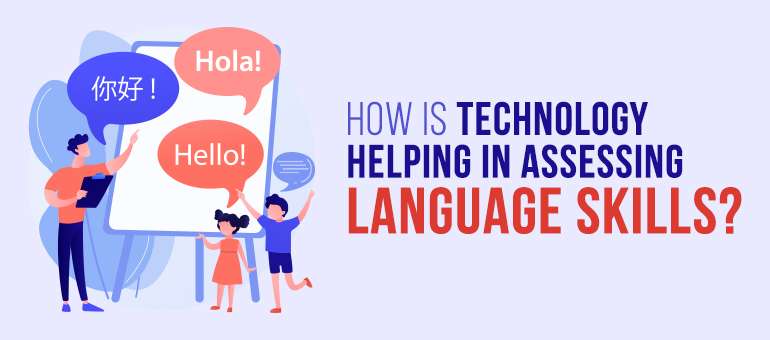Language proficiency is a dominating aspect of communication that needs a detailed discussion. Communicating effectively with a team and communicating effectively within it are two different sides of a coin. You have to look both ways to achieve the desired outcome.
Most global organizations find ways to innovate and create an impact through their business solutions. Working with different teams is often a challenge here. People coming from different walks of life join hands to fulfill organizational goals. The momentum builds up through effective communication in the first place.
Here, technology plays a vital role in redefining language assessments, and one can leverage it to accomplish organizational goals. Ever since the pandemic hit the business work, there were several challenges, including recruiting resources suitable to the job and working in a home-based setup. You may have relied on a human resources management software system to do the job. What about training employees on language proficiency?
We are referring to employees with different language skills and how they contribute to making a brand authentic. An HR payroll and management software system helps you obtain employee data during the performance appraisal cycle. Similarly, you can use language assessments scores to offer constructive feedback to your employees. You do need language-proficient leaders who can communicate to their teams without any communication barriers.
The need for language assessmentIn a modern-day corporate setup, you are supposed to interact with different teams having global exposure. It makes sense to find a middle ground where you can express your thoughts and ideas with clarity. It leads to an effective outcome and faster problem resolution.
Take an example of an American client whose native language is English. You, located at the Indian branch, are proficient in speaking fluent English. However, do you make efforts to realize if you are putting forth your points precisely? Maybe the American client is finding it hard to understand the aim and objectives of a meeting. How do you handle such a situation?
Many organizations conduct language training to assess an employee’s language proficiency and if it’s the best-suited job that employee. In BPOs where language proficiency is the key to business success, HR counts on technology to help them out.
Many language training providers like go FLUENT help employees assess their language proficiency in multiple languages using an AI-based framework.
When recruiting new employees, the language assessment test can help them realize the potential of an individual and what level of training you should provide in their chosen language. Does it help me achieve my business goals? For a diversified workforce aiming to increase productivity, assessing language skills is crucial.
How does technology help in assessing language skills?When we talk about the role of technology in assessing language skills, one should know that these assessments should be valid, reliable, and authentic. A lot depends on the language test score in measuring language proficiency in employees and if they have learned something out of it. Let’s understand that in detail.
Help reduce language proficiency gapsWhile recruiting new employees, HR may find it difficult to assess language skills accurately. The reason is that a candidate could be a non-native speaker but possess fluency in a particular language. Does that help you assess employees better? No. The results will not be accurate.
If you work with expert learning professionals, you will find that they are versed in finding communication gaps. They can help you make informed decisions regarding task allotment. How? When you conduct an AI-based language assessment, it can provide accurate results, and you can count on machine learning, for that matter.
Many language training providers include assessment methods like listening and repeating sentences, speech recognition, etc. The assessment comprises both speaking and writing tests.
AI facilitates personalized trainingPersonalization is the key to retaining talent and increasing employee productivity. When you focus on listening to an employee’s or client’s doubts and grievances, they are happy to contribute more towards achieving organizational goals. It could be a member of a customer service team or an individual in a leadership position.
Both are required to communicate clearly. Not just that, one needs to be proficient in speaking and writing. Your employees could be working with global teams, and assessing their language capability is one way to step towards a higher role.
Let us understand it in a layman’s language. A candidate hired at an executive level wants to move to a different role. You, as a decision-maker, were able to assess his/her potential and want to offer them a lead role. Don’t you want them to enhance their language skills so they can communicate effectively with different designations?
Here, you can personalize language assessment and put focus on improving weaker areas.
Key inclusions in technology-based language assessment While creating a technology-based language assessment, one must find answers to the following questions:- Is the assessment reliable?
- Can I get accurate outcomes?
- Does it help the trainee gain skills to use in real-world scenarios?
- Is the training employee-friendly?
- What are the defined objectives of the assessment?
- Does it help in reducing language proficiency gaps?
When you have answers to these questions, you can create language tests with clarity. The idea behind including these questions before training is to measure the effectiveness of the assessment. It may cost money to an organization, so it should be an investment than a cost.
If you’ve got innovative minds at work, you can think of creating resources that can help your employees be good at learning a second language. If you glance through your HR management software, you may find how things get organized, and each function offers a different solution.
Similarly, you can create a Help page and integrate it with your HR Software. Employees can download blogs, articles, and guides to understand the importance of language assessments at the workplace.
Managing communication gapsA manager may flaunt language proficiency in writing but is not able to speak well in English. It’s like assessing the technical ability of HR using an HRMS and comparing it with employees who use the same software to ease their day. Language training providers study such cases in detail and then initiate creating assessments.
Earlier, we spoke about the role of technology in bridging language proficiency gaps. It is the need of the hour. Even if you work with domestic teams, you have to gain proficiency in the regional language to break the ice of getting the work done. How do you manage the communication gap here?
Organizations can tie up with language training providers who can help create personalized assessments based on the training and needs analysis. These training providers boast extensive experience in the field of training and development.
Reaching a middle groundAfter all that said, you must have realized the importance of technology in building language-proficient leaders in their respective areas. It takes a little effort to create assessments that can help you bridge language proficiency gaps. You have to put your heart into a task to turn into a master creation.
Similarly, when training your employees to be proficient in a non-native language, you should start assessing training needs and creating measurable objectives for the training program. This way, you can invest in producing resourceful future leaders.



